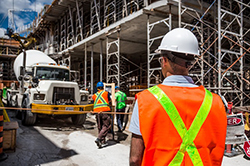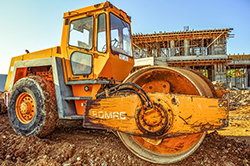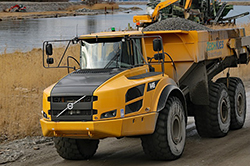 An electrical contractor runs miles of wiring through what will be a three-story office building. Following completion, the contractor tests the wiring, finds it satisfactory and leaves the job. After other subcontractors hang and paint the walls and do other finishing work, the general contractor tests all systems.
An electrical contractor runs miles of wiring through what will be a three-story office building. Following completion, the contractor tests the wiring, finds it satisfactory and leaves the job. After other subcontractors hang and paint the walls and do other finishing work, the general contractor tests all systems.
This time, the electrical system fails. The GC summons the electrical contractor back; after more testing and diagnosis, the contractor concludes that there are faults in two segments of the system on different floors and adjacent sides of the structure. Fixing the problem will require tearing out the finished walls and a few appliances attached to them (a dishwasher in an office kitchen area, computer network equipment, etc.).
Tearing these things out, repairing the faulty wiring, and reinstalling the walls and finishing them so they look flawless will cost much more than simply fixing the electrical problem. The cost is far beyond what the contractor can afford to pay out of pocket. Will its Commercial General Liability insurance help? The answer depends on the state where the building is located.
The ISO CGL policy covers the insured contractor’s legal liability for physical damage:
To tangible property, including all resulting loss of its use, or loss of use of tangible property that is not physically injured; and Caused by an occurrence, which is “an accident, including continuous or repeated exposure to substantially the same general harmful conditions.”
In addition, the policy states that it does not cover the insured’s liability for property damage:
To work or operations the insured performed or which a subcontractor performed on the insured’s behalf, if the damage arises out of any part of the work and it occurs after the work’s completion; and To other tangible property that is unusable or less useful to the owner because it includes the insured’s work that is known or thought to be defective, deficient, inadequate or dangerous, if fixing the insured’s work will restore the property to usefulness.
Some courts have ruled that the CGL policy covers the cost of tearing out and reinstalling undamaged property when that is necessary to fix the defective work. A 2002 federal appeals court ruling in a Washington state case said that the removal and destruction of other subcontractors’ work due to the insured’s defective work is property damage, as the CGL defines the term. The court also said that the insured’s performance of defective work met the policy’s definition of “occurrence.”
A 2010 decision from Washington state reached a similar conclusion — unintentionally providing defective products to an installer was an “occurrence,” and removal and replacement of other suppliers’ products and work was “property damage.” Courts in Alaska and Oklahoma have ruled that the policy provision that excludes coverage for unusable tangible property did not apply because of a second provision that gives coverage back for loss of use resulting from sudden or accidental injury to the insured’s work. The courts felt that installing defective components was done accidentally.
Conversely, courts in Arizona, Maryland and South Carolina have held that tearing out and replacing undamaged property is not physical damage caused by an “occurrence” because it is not an accident. Rather, the courts saw it as a cost associated with a project.
Since the courts differ so much from one state to another, it might be helpful for a contractor to know in advance what a particular state requires. The contractor’s insurance agent might also know which insurance companies have a history of paying for these types of claims. The contractor could find that it is worthwhile to buy coverage from these companies even if they charge higher premiums.

 Your construction business depends on independent contractors who may perform a variety of tasks, including demolition, installation or painting. Because your business depends on quality work performed in a timely manner, use seven tips to ensure you hire reliable independent contractors.
Your construction business depends on independent contractors who may perform a variety of tasks, including demolition, installation or painting. Because your business depends on quality work performed in a timely manner, use seven tips to ensure you hire reliable independent contractors. The theory of respondeat superior makes employers vicariously liable for wrongful acts committed by employees during the course and scope of their employment. However, the “going and coming” rule generally exempts employers from liability for wrongful acts committed by employees while on their way to and from work, because employees are said to be outside of the course and scope of employment during their daily commute.
The theory of respondeat superior makes employers vicariously liable for wrongful acts committed by employees during the course and scope of their employment. However, the “going and coming” rule generally exempts employers from liability for wrongful acts committed by employees while on their way to and from work, because employees are said to be outside of the course and scope of employment during their daily commute. In October 2010, a construction worker in Pennsylvania was crushed to death by a section of a steel plate. The month before, a worker in Houston died when a pallet carrying a one-ton load struck him. In Maryland, two bar joists fell off a stack of joists on a flatbed truck, killing a worker.
In October 2010, a construction worker in Pennsylvania was crushed to death by a section of a steel plate. The month before, a worker in Houston died when a pallet carrying a one-ton load struck him. In Maryland, two bar joists fell off a stack of joists on a flatbed truck, killing a worker. As an artisan contractor, you have invested years in perfecting your craft. Protect your professional reputation, personal assets and business future with artisan contractor insurance.
As an artisan contractor, you have invested years in perfecting your craft. Protect your professional reputation, personal assets and business future with artisan contractor insurance. Welders can use over 100 different processes to join or cut metal. As a welder, you work around hot metals and tools in a variety of hazardous locations. To protect yourself, your business and your personal assets, purchase welders insurance.
Welders can use over 100 different processes to join or cut metal. As a welder, you work around hot metals and tools in a variety of hazardous locations. To protect yourself, your business and your personal assets, purchase welders insurance.







